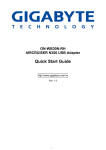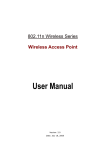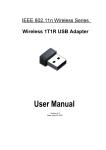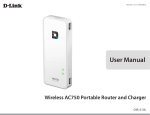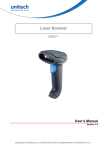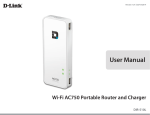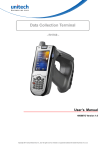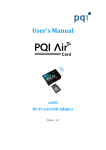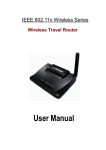Download User Manual
Transcript
IEEE 802.11n Wireless Series Wireless 1T2R PCI-E Card User Manual Version: 2.2, March 10, 2010. Wireless 11n 1T2R PCI-E Card FCC Certifications Federal Communication Commission Interference Statement This equipment has been tested and found to comply with the limits for a Class B digital device, pursuant to Part 15 of the FCC Rules. These limits are designed to provide reasonable protection against harmful interference in a residential installation. This equipment generates, uses and can radiate radio frequency energy and, if not installed and used in accordance with the instructions, may cause harmful interference to radio communications. However, there is no guarantee that interference will not occur in a particular installation. If this equipment does cause harmful interference to radio or television reception, which can be determined by turning the equipment off and on, the user is encouraged to try to correct the interference by one of the following measures: -Reorient or relocate the receiving antenna. -Increase the separation between the equipment and receiver. -Connect the equipment into an outlet on a circuit different from that to which the receiver is connected. -Consult the dealer or an experienced radio/TV technician for help. This device complies with Part 15 of the FCC Rules. Operation is subject to the following two conditions: (1) This device may not cause harmful interference, and (2) this device must accept any interference received, including interference that may cause undesired operation. FCC Caution: Any changes or modifications not expressly approved by the party responsible for compliance could void the user's authority to operate this equipment. IMPORTANT NOTE: FCC Radiation Exposure Statement: This equipment complies with FCC radiation exposure limits set forth for an uncontrolled environment. This equipment should be installed and operated with minimum distance 20cm between the radiator & your body. This transmitter must not be co-located or operating in conjunction with any other antenna or transmitter. IEEE 802.11b/g or 802.11n operation of this product in the U.S.A. is firmware-limited to channels 1 through 11. -2- Wireless 11n 1T2R PCI-E Card CE Mark Warning This equipment complies with the requirements relating to electromagnetic compatibility, EN 55022 Class B for ITE, the essential protection requirement of Council Directive 2004/108/EC on the approximation of the laws of the Member States relating to electromagnetic compatibility and R&TTE Directive 1999/5/EC to meet the regulation of the radio equipment and telecommunications terminal equipment. Company has an on-going policy of upgrading its products and it may be possible that information in this document is not up-to-date. Please check with your local distributors for the latest information. No part of this document can be copied or reproduced in any form without written consent from the company. Trademarks: All trade names and trademarks are the properties of their respective companies. Copyright ©2010, All Rights Reserved. 經型式認證合格之低功率射頻電機,非經許可,公司、商號或使用者均不得擅自變更頻率、 加大功率或變更原設計之特性及功能。 低功率射頻電機之使用不得影響飛航安全及干擾合法通信;經發現有干擾現象時,應立即停 用,並改善至無干擾時方得繼續使用。前項合法通信,指依電信法規定作業之無線電通信。 低功率射頻電機須忍受合法通信或工業、科學及醫療用電波輻射性電機設備之干擾。 -3- Wireless 11n 1T2R PCI-E Card Package Contents The following contents should be found in your box: One IEEE 802.11n 1T2R PCI-E Card Two antennas One resource CD, including: REALTEK 11n PCI-E Wireless LAN Driver and Utility User’s Manual QIG Note: Make sure that the package contains the above items. If any of the listed items are damaged or missing, please contact with your distributor. -4- Wireless 11n 1T2R PCI-E Card CONTENTS Chapter 1 Introduction.....................................................................................................6 1.1 Overview of the product..........................................................................................6 1.2 Features .................................................................................................................6 1.3 Application Diagram................................................................................................7 1.4 LED Status .............................................................................................................7 Chapter 2 Installation Guide for Windows .......................................................................8 2.1 Hardware Installation ..............................................................................................8 2.2 Software Installation ...............................................................................................8 2.2.1 Overview ....................................................................................................8 2.2.2 Software Installation...................................................................................8 Chapter 3 Management Guide......................................................................................12 3.1 Making a Basic Network Connection ....................................................................12 3.1.1 Select a configuration tool........................................................................12 3.1.2 To connect with Microsoft Zero Configuration tool ...................................12 3.1.3 To connect with 802.11n Wireless LAN Utility..........................................13 3.2 Introduction to the 802.11n Wireless LAN Utility...................................................14 3.2.1 Interfaces .................................................................................................14 3.2.2 Available Network ....................................................................................14 3.2.3 Profile.......................................................................................................16 3.2.4 General ....................................................................................................20 3.2.5 Advanced .................................................................................................21 3.2.6 Status.......................................................................................................22 3.2.7 Statistics...................................................................................................23 3.2.8 Wi-Fi Protect Setup ..................................................................................25 Chapter 4 Introduction for Vista User ..........................................................................27 4.1 Installation ............................................................................................................27 4.1.1 Overview ..................................................................................................27 4.1.2 Software Installation for vista ...................................................................27 4.2 Management Guide ..............................................................................................30 4.2.1 Interfaces .................................................................................................30 4.2.2 Available Network ....................................................................................31 4.2.3 Profile.......................................................................................................32 4.2.4 General ....................................................................................................35 4.2.5 Advanced .................................................................................................35 4.2.6 Status.......................................................................................................36 4.2.7 Statistics...................................................................................................38 4.2.8 Wi-Fi Protect Setup ..................................................................................39 Chapter 5 Introduction for Windows 7 User.................................................................42 4.1 Software Installation .............................................................................................42 4.2 Management Guide ..............................................................................................44 4.2.1 Available Network ....................................................................................45 4.2.3 Profile.......................................................................................................47 4.2.4 General ....................................................................................................50 4.2.6 Status.......................................................................................................51 4.2.7 Statistics...................................................................................................52 4.2.8 Wi-Fi Protect Setup ..................................................................................54 4.2.9 Virtual WiFi...............................................................................................56 Appendix A: Specifications ................................................................................................59 Appendix B: Glossary ........................................................................................................60 -5- Wireless 11n 1T2R PCI-E Card Chapter 1 Introduction Thank you for purchasing this product. Read this chapter to know about your IEEE 802.11n wireless 1T2R PCI-E Adapter. 1.1 Overview of the product Comply with 802.11n Standards The IEEE 802.11n Wireless PCI-E adapter provides users to launch IEEE 802.11n wireless network at 300 Mbps in the 2.4GHz band. It can also interoperate with all 11Mbps wireless (802.11b) products and all 54 Mbps wireless (802.11g) products. Reliable Coverage and Connection The PCI-E Card adopts MIMO has two external detachable omni directional antennas providing even better wireless performance, transmission rates, stability and coverage. You can configure this adapter with ad-hoc mode to connect to other 2.4 GHz wireless computers, or with infrastructure mode to connect to a wireless AP or wireless router for accessing to Internet. Easy Installation, enhanced Wireless Security As for installation, this wireless PCI-E adapter provides you the flexibility to install your PC in the most convenient location available, without the cost of running network cables. So you can easily connect your PC to your Wireless Access Point and enjoy the pleasure of Wi-Fi. Also, this product supports WPA / WPA2 encryptions and mechanisms, allowing users to quickly and easily configure wireless security. 1.2 Features High Speed transfer data rate up to 300 Mbps Support QoS Enhancement ( WMM, WMM-PS Client mode) Supports wireless data encryption with 64/128-bit WPA,WPA2 Support frame aggregation, Power saving mechanism, channel management and co-existence Transmit Opportunity (TXOP) Short Inter-Frame Space (SIFS) bursting for higher multimedia bandwidth Supports auto-installation and diagnostic utilities Two 802.11n/b/g wireless SMA antennas (Standard 1.8dB) Supports driver for Windows 7, XP 86, XP 64, Vista 86, Vista 64, Linux -6- Wireless 11n 1T2R PCI-E Card 1.3 Application Diagram 1.4 LED Status LED Indications Link LED Act LED Status Working Status Off The adapter is Radio off Blink green The adapter is already connected Blink green and flashing The adapter is already connected but intermittently is not transmitting or receiving data Blink green and fast flashing Off The adapter is activity and transmitting of receiving data. The adapter is Radio off -7- Wireless 11n 1T2R PCI-E Card Chapter 2 Installation Guide for Windows 2.1 Hardware Installation 1. Make sure the computer is turned off. Remove the expansion slot cover from the computer. 2. Carefully slide the Wireless 1T2R PCI-E Card into the PCI-E slot. Push evenly and slowly and ensure it is properly seated. 3. Secure the antennas on. 4. Turn on your computer. Windows detects the new hardware automatically. 2.2 Software Installation 2.2.1 Overview The following driver installation guide uses Windows XP as the presumed operation system. 1. The system finds the newly installed device automatically. Click Cancel to close this window. 2.2.2 Software Installation 1. Insert the CD into your CD-Rom, and then appear an interface. Please click on PCI-E> Driver> Win to start the installation. -8- Wireless 11n 1T2R PCI-E Card 2. The language-selecting window pops up. Please select the language you use and click “Next”. 3. The welcome window pops up. Click the “Next” button to proceed. -9- Wireless 11n 1T2R PCI-E Card 4. Click the “Install” button to start installing. 5. Please wait while installation. - 10 - Wireless 11n 1T2R PCI-E Card 6. Please wait again while installation 7. After all the steps above, you will see the screen below, click Finish to reboot the system. - 11 - Wireless 11n 1T2R PCI-E Card Chapter 3 Management Guide This chapter describes how to configure your Adapter for wireless connectivity on your Wireless Local Area Network (WLAN) and use the data security encryption features. After Installing the Adapter, the Adapter’s tray icon will appear in your system tray. It appears at the bottom of the screen, and shows the signal strength using color and the received signal strength indication (RSSI). If the icon is purple, there is no connection. If the icon is white, the network is dropping off. If the icon is green, there is good signal strength. If the icon is green, there is excellent signal strength. 3.1 Making a Basic Network Connection 3.1.1 Select a configuration tool In the following instruction for making a network connection, we use the provided Utility to configure your wireless network settings. Note: You could use either the software we provide or Microsoft Zero Configuration tool to configure this adapter. 3.1.2 To connect with Microsoft Zero Configuration tool After specifying the Microsoft Zero Configuration tool to configure your wireless network, right click on the icon on system tray. Select “View Available Wireless Networks” to specify your wireless network. The tool shows the available wireless networks. Select your demanding network to connect with. To connect to a wireless network, please click Change advanced settings to be compatible with your wireless network settings. - 12 - Wireless 11n 1T2R PCI-E Card 3.1.3 To connect with 802.11n Wireless LAN Utility We provide this Utility for users to connect to a wireless network easily. It provides more information and configuration for this adapter. As default, the Utility is started automatically upon starting your computer and connects to a connectable wireless network with best signal strength and with no security setting. Right click on the icon in the system tray and select Open Config utility if the Utility does not start. Please refer to the following chapters to get information regarding to the functions of this Utility. - 13 - Wireless 11n 1T2R PCI-E Card 3.2 Introduction to the 802.11n Wireless LAN Utility Note: The Utility in Linux and Mac are different from the following. 3.2.1 Interfaces 1. Functional Buttons: on top of the window. You can click each button to access each configuration window. 2. Configuration Column: Center of the Utility window. Make your changes for each function in this part. 3. Optional Table: “Show Tray Icon”, “Disable Adapter”, “Radio off” 3.2.2 Available Network This network lists the available wireless networks. The Utility connects to a wireless network with best signal strength automatically. You can refresh the connecting network by clicking on the network name and click the Refresh button. In the center of the Utility windows, you will see detail information of each network. - 14 - Wireless 11n 1T2R PCI-E Card Available Network Information: Items SSID Information The name of the IEEE 802.11 wireless network. This field has a maximum limit of 32 characters. Channel Encryption Display current channel in use. Shows the encryption mode in use. There are total 4 modes: None, WEP, TKIP and AES. Network Authentication Signal Shows the authentication mode in use. This percentage shows the strength of the signal. The type of network and the station currently connected are shown here. The options include : Type • Infrastructure - All wireless clients will connect to an access point or wireless router. • Ad-Hoc - Directly connecting to another computer, for - 15 - Wireless 11n 1T2R PCI-E Card peer-to-peer communication, using wireless network adapters on each computer, such as two or more wireless adapters. BSSID Support Rates The IEEE MAC address of locally-managed, generating from a 46 random code. Show current rate Note: 1) An Infrastructure network contains an Access Point or wireless router. All the wireless devices or clients will connect to the wireless router or access point. 2) An Ad-Hoc network contains only clients, such as laptops with wireless desktop adapters. All the adapters must be in Ad-Hoc mode to communicate. 3.2.3 Profile 1. Add a new profile: (1) Selecting an available network in the “Available Network” function then click the Add to Profile button., or double click the network name. You could also add a new profile quickly by clicking the Add button in the “Profile” function. Note: If the network you add to profile is not encrypted, “Unsecured network” window will pop up, then Click “OK”. (2) It displays “Wireless Network Properties” dialog box. This profile page allows users to save different wireless settings, which helps users to get access to wireless networks at home, office or other wireless network environments quickly. - 16 - Wireless 11n 1T2R PCI-E Card In this dialog box, there are some items: Items Information Profile Name Identifies the configuration profile .This name must be unique. Note that the profile names are not case-sensitive. Network The IEEE 802.11n wireless network name, using default name defined by Name(SSID) system. This field has a maximum limit of 32 characters. (3) Channel (Country Region Code): seven countries to choose. Country channel list: Country Channel Range Country Channel Range USA CH1 ~ CH11 FRANCE CH10 ~ CH13 CANADA CH1 ~ CH11 JAPAN CH1 ~ CH14 ETSI CH1 ~ CH13 ISRAEL CH1 ~ CH13 SPAIN CH10 ~ CH11 - 17 - Wireless 11n 1T2R PCI-E Card (4) Wireless Network Security A. Network Authentication There are 7 types supported: Open System, Shared Key, WPA-PSK, WPA2-PSK, and WPA 802.1X, WPA2 802.1X, WEP 802.1X. Please select a type from the drop down list. Open System: enable an adapter to attempt authentication regardless of its WEP settings. It will only associate with the access point if the WEP keys on both the adapter and the access point match. Shared-key: only allows the adapter to associate with access points that have the same WEP key. 802.1x: This item appears while the environment is set to an open authentication with WEP encryption. The section is also available in WPA and WPA2 authentication types. Preshared Key (PSK): This is the shared secret between AP and STA. For WPA-PSK, WPA2-PSK and WPA-NONE authentication mode, this field must be filled with characters longer than 8 and less than 32 lengths. The following dialog appears if you have input invalid values. WEP Key: Only available when using WEP encryption algorithm. The key must match AP's key. Only using the same cryptographic key to access the computer, the internet can storage, and decryption the information from other computer. - 18 - Wireless 11n 1T2R PCI-E Card B. Data Encryption: There are 4 types supported: Disabled, WEP, TKIP and AES. The available encryption selection will differ from the authentication type you have chosen, the result is shown below: Authentication Data encryption Available Encryption Selection Open System Disabled, WEP Shared Key , WEP 802.1X WEP WPA-PSK, WPA2-PSK, and WPA TKIP, AES 802.1X, WPA2 802.1X Note: Select different Security Options, the configurations are different; you can select the appropriate security option and configure the exact key as your need. TKIP: "Temporary Key Integration communication Protocol", it provide each packet's key mixture, message integration and key reconstruction mechanism. TKIP can use with personal or the enterprise network validation. AES: “Advanced Encryption Standard”, it is a new method that the wireless transmission of privacy protection. AES encryption methods provides more careful than TKIP. (5) Finish the configuration, then click “OK”, that network has been added to the profile. - 19 - Wireless 11n 1T2R PCI-E Card Profile List: The list shows all the profiles you have added before. Buttons: You can click on these buttons to Add a new profile, Remove, Edit, Duplicate or Set Default an old profile. 3.2.4 General In this window, there are some items as following: Items Information Status Currently connection status Speed Show current transmit rate and receive rate Type Encryption SSID Network type in use Encryption type in use The name of the IEEE 802.11 wireless network. This field has a maximum limit of 32 characters - 20 - Wireless 11n 1T2R PCI-E Card Signal Strength Link Quality Network Address 3.2.5 Receive signal strength Display connection quality based on signal strength A. MAC Address : The MAC address of the wireless network adapter. B. IP Address : IP address of current connection. C. Subnet Mask : Subnet mask of current connection. D. Gateway : Gateway of current connection. Advanced This screen below allows you to make advanced configuration for the profile. Please refer to the following chart for definitions of each item. 1. Preamble Mode The length of CRC blocks in the frames during the wireless communication. Select the options from the drop list : (1) Long (2)Short (3)Auto. - 21 - Wireless 11n 1T2R PCI-E Card 2. Channel Plan The selected Country: FCC, IC, ETSI, Spain, France, MKK, MKK1, Israel, TELEC, Default 3. Threshold (1) Fragment Threshold This value should remain at its default setting of 2347. If you experience a high packet error rate, you may slightly increase your fragmentation threshold within the value range of 256 to 2432. Setting the fragmentation threshold too low may result in poor performance. (2) RTS Threshold Request To Send threshold. This value should remain at its default setting of 2346. If you encounter inconsistent data flow, only minor modifications to the value range between 0 and 2432 are recommended. 3.2.6 Status The Status tab contains general information about the program and its operations. The current Status tab needn’t any configurations. - 22 - Wireless 11n 1T2R PCI-E Card The following table describes the items found on the Status screen. Items Manufacturer NDIS Driver Version Encryption Authenticate Channel Set MAC Address Data Rate(Auto) Channel Frequency Status SSID Network Type Information The name of manufacturing this product The version of Network Driver Interface Specification Here displays the encryption type the device is using This shows whether the server based authentication is used. Appears the Channel you use The MAC address of the wireless network adapter. Show current transmit rate and receive rate Shows the channel in use (1~14) Current connection status The SSID of the wireless system. The type of network and the station currently connected are shown here. The options include : Infrastructure, Ad Hoc The power save mode have three mode, as follows : • Max - Selects maximum mode to let the access point buffer incoming messages for the Adapter. The Adapter will detect the access point if any messages are waiting periodically. Power Save Mode • Min – Min mode uses minimum when retrieving a large number of packets, then switches back to power save mode after retrieving the packets. • None - Turns power saving off, thus powering up the Wireless PCI-E Adapter continuously for a short message response time. Associated AP MAC Up Time 3.2.7 The MAC Address of associated AP Record life time Statistics Statistics page displays the detail counter information based on 802.11 MIB counters. This page translates the MIB counters into a format easier for user to understand. It show receiving and transmitting statistical information about the following receiving and transmitting diagnostics for frames received by or transmitted to the wireless network adapter. - 23 - Wireless 11n 1T2R PCI-E Card Items Information TX OK Successfully transmitted frames numbers. TX Error Frames numbers transmitting with error. RX OK Successfully received frames numbers. Rx Packet Count RX Retry RX ICV Error Reset Counter The packets of receiving frames Frames numbers re-receiving Integrity Check Value receiving with error. Reset counters to zero. - 24 - Wireless 11n 1T2R PCI-E Card 3.2.8 Wi-Fi Protect Setup The primary goal of Wi-Fi Protected Setup (Wi-Fi Simple Configuration) is to simplify the security setup and management of Wi-Fi networks. This adapter supports the configuration setup using PIN configuration method or PBC configuration method. If the wireless card supports Wi-Fi Protected Setup (WPS), you can establish a wireless connection between wireless card and router using either Push Button Configuration (PBC) method or PIN method. Here we will introduce two ways to configure the QSS (QSS is known as rapid security settings, by pressing the wireless router and wireless card on the QSS button to automatically set up WPA2 secure connection level without the router or network adapter management software to conduct the cumbersome interface settings, greatly simplifying the operation of the wireless security settings.) Pin Code: 8-digit numbers. It is randomly generated from system 1. PIN method Click the button “Pin Input Config (PIN)”, and then come to the following figure. Click the button “Yes”, you can select one of the AP. - 25 - Wireless 11n 1T2R PCI-E Card In this figure, you can operate these buttons “Refresh / Select / Cancel”. Select the name of one AP, then click “Select” button, you could use PIN method to configure the QSS. Double click the Internet WEB browser icon on your desktop screen. Type the IP address of you selected router/AP into the URL and press Enter, and then you can enter the configuration. Please enter the WPS ( Wi-Fi ) configuration page, type the PIN code of adapter and click confirm button to build WPS connection. WPS connection will be successful by PIN method after several minutes. 2. PBC (Push Button Configuration) method After pushing the PBC button, please push the physical button on your AP or visual button on the WPS config page, then come to the following figure. Please enter the WPS ( Wi-Fi ) configuration page of your desired router/AP, and then start PBC connection. WPS connection will be successful by PBC method after several minutes. - 26 - Wireless 11n 1T2R PCI-E Card Chapter 4 Introduction for Vista User 4.1 Installation 4.1.1 Overview The Adapter’s Setup Wizard will guide you through the Installation procedure for Vista. The Setup Wizard will install the REALTEK 11n PCI-E Wireless LAN Driver and Utility. When you install the hardware prior to before installing the software, the system will prompt “Found New Hardware Wizard”, click Cancel, and run the Setup Wizard program on the CD-ROM. 4.1.2 Software Installation for vista 1. Insert the CD into your CD-Rom, and then appear an interface. Please click on PCI-E> Driver> Win to start the installation. 2. The language-selecting window pops up. Please select the language you use and click “Next”. - 27 - Wireless 11n 1T2R PCI-E Card 3. The welcome window pops up. Click the “Next” button to proceed. - 28 - Wireless 11n 1T2R PCI-E Card 4. Click the “Install” button to start installing. 5. Please wait again while installation 6. After all the steps above, you will see the screen below, Select “Yes” or “No”, then click Finish. - 29 - Wireless 11n 1T2R PCI-E Card 4.2 Management Guide This chapter describes how to configure your Adapter for wireless connectivity on your Wireless Local Area Network (WLAN) and use the data security encryption features. After Installing the Adapter, the Adapter’s tray icon will appear in your system tray. It appears at the bottom of the screen, and shows the signal strength using color and the received signal strength indication (RSSI). 4.2.1 Interfaces 1. Functional Buttons : on top of the window. You can click each button to access each configuration window. 2. Configuration Column : Center of the Utility window. Make your changes for each function in this part. 3. Optional Table : “Show Tray Icon”, ”Disable Adapter”, ”Radio off”, ”Windows Zero Config” - 30 - Wireless 11n 1T2R PCI-E Card 4.2.2 Available Network This network lists the available wireless networks. The Utility connects to a wireless network with best signal strength automatically. You can refresh the connecting network by clicking on the network name and click the Refresh button. In the center of the Utility windows, you will see detail information of each network. Available Network Information: Items SSID Information The name of the IEEE 802.11 wireless network. This field has a maximum limit of 32 characters. Channel Encryption Display current channel in use. Shows the encryption mode in use. There are total 4 modes: None, WEP, TKIP and AES. Network Authentication Signal Shows the authentication mode in use. This percentage shows the strength of the signal. - 31 - Wireless 11n 1T2R PCI-E Card Type The type of network and the station currently connected are shown here. The options include : Infrastructure & Ad-Hoc BSSID Support Rates 4.2.3 The IEEE MAC address of locally-managed, generating from a 46 random code. Show current rate Profile 1. Add a new profile: (1) Selecting an available network in the “Available Network” function then click the Add to Profile button, or double click the network name. You could also add a new profile quickly by clicking the Add button in the “Profile” function. Note: If the network you add to profile is not encrypted, “Unsecured network” window will pop up, then Click “OK”. (2) It displays “Wireless Network Properties” dialog box. This profile page allows users to save different wireless settings, which helps users to get access to wireless networks at home, office or other wireless network environments quickly. - 32 - Wireless 11n 1T2R PCI-E Card (3). Channel (Country Region Code): seven countries to choose. Country channel list: Country Channel Range Country Channel Range USA CH1 ~ CH11 FRANCE CH10 ~ CH13 CANADA CH1 ~ CH11 JAPAN CH1 ~ CH14 ETSI CH1 ~ CH13 ISRAEL CH1 ~ CH13 SPAIN CH10 ~ CH11 (4) Wireless Network Security A. Network Authentication Select the Security tab in the screen above. To define the security mode, select the desired security mode as follows. There are 7 types supported: Open System, Shared Key, WPA-PSK, WPA2-PSK, and WPA 802.1X, WPA2 802.1X, WEP 802.1X, Please select a type from the drop down list - 33 - Wireless 11n 1T2R PCI-E Card B. Data Encryption: There are 4 types supported: Disabled, WEP, TKIP and AES. The available encryption selection will differ from the authentication type you have chosen, the result is shown below: Authentication Data encryption Available Encryption Selection Open System Disabled, WEP Shared Key WEP WPA-PSK, WPA2-PSK, and TKIP, AES WPA 802.1X, WPA2 802.1X WEP 802.1X WEP Note: Select different Security Options, the configurations are different; you can select the appropriate security option and configure the exact key as your need. (5) Finish the configuration, and then click “OK”, that network has been added to the profile. Profile List: The list shows all the profiles you have added before. Buttons: You can click on these buttons to Add a new profile, Remove, Edit, Duplicate or Set Default an old profile. - 34 - Wireless 11n 1T2R PCI-E Card 4.2.4 General Click the “General” button, you will see there are some items as following: Items Information Status Currently connection status Speed Show current transmit rate and receive rate Type Encryption SSID Network type in use. Encryption type in use. The name of the IEEE 802.11 wireless network. This field has a maximum limit of 32 characters. Signal Strength Link Quality 4.2.5 Receive signal strength Display connection quality based on signal strength A. MAC Address : The MAC address of the wireless network adapter. Network B. IP Address : IP address of current connection. Address C. Subnet Mask : Subnet mask of current connection. D. Gateway : Gateway of current connection. Advanced This screen below allows you to make advanced configuration for the profile. Please refer to the following chart for definitions of each item. - 35 - Wireless 11n 1T2R PCI-E Card 4.2.6 Status The Status tab contains general information about the program and its operations. The current Status tab needn’t any configurations. The following table describes the items found on the Status screen. Items Manufacturer NDIS Driver Version Encryption Authenticate Channel Set MAC Address Data Rate(Auto) Channel Frequency Information The name of manufacturing this product The version of Network Driver Interface Specification Here displays the encryption type the device is using This shows whether the server based authentication is used. Appears the Channel you use The MAC address of the wireless network adapter. Show current transmit rate and receive rate Shows the channel in use (1~14) - 36 - Wireless 11n 1T2R PCI-E Card Status SSID Network Type Current connection status The SSID of the wireless system. The type of network and the station currently connected are shown here. The options include : Infrastructure, Ad Hoc Power Save Mode Associated AP MAC Up Time The power save mode have three mode: Max, Min, None The MAC Address of associated AP Record life time - 37 - Wireless 11n 1T2R PCI-E Card 4.2.7 Statistics Statistics page displays the detail counter information based on 802.11 MIB counters. This page translates the MIB counters into a format easier for user to understand. It show receiving and transmitting statistical information about the following receiving and transmitting diagnostics for frames received by or transmitted to the wireless network adapter. - 38 - Wireless 11n 1T2R PCI-E Card Items Information TX OK Successfully transmitted frames numbers. TX Error Frames numbers transmitting with error. RX OK Successfully received frames numbers. Rx Packet Count RX Retry RX ICV Error Reset Counter 4.2.8 The packets of receiving frames Frames numbers re-receiving Integrity Check Value receiving with error. Reset counters to zero. Wi-Fi Protect Setup The primary goal of Wi-Fi Protected Setup (Wi-Fi Simple Configuration) is to simplify the security setup and management of Wi-Fi networks. This adapter supports the configuration setup using PIN configuration method or PBC configuration method. If the wireless card supports Wi-Fi Protected Setup (WPS), you can establish a wireless connection between wireless card and router using either Push Button Configuration (PBC) method or PIN method. - 39 - Wireless 11n 1T2R PCI-E Card Here we will introduce two ways to configure the QSS (QSS is known as rapid security settings, by pressing the wireless router and wireless card on the QSS button to automatically set up WPA2 secure connection level without the router or network adapter management software to conduct the cumbersome interface settings, greatly simplifying the operation of the wireless security settings.) Pin Code: 8-digit numbers. It is randomly generated from system 1. PIN method Click the button “Pin Input Config (PIN)”, and then come to the following figure. Click the button “Yes”, you can select one of the AP. In this figure, you can operate these buttons “Refresh / Select / Cancel”. Select the name of one AP, then click “Select” button, you could use PIN method to configure the QSS. - 40 - Wireless 11n 1T2R PCI-E Card Double click the Internet WEB browser icon on your desktop screen. Type the IP address of you selected router/AP into the URL and press Enter, and then you can enter the configuration. Please enter the WPS ( Wi-Fi ) configuration page, type the PIN code of adapter and click confirm button to build WPS connection. WPS connection will be successful by PIN method after several minutes. 2. PBC (Push Button Configuration) method After pushing the PBC button, Please push the physical button on your AP or visual button on the WPS config page, then come to the following figure. Please enter the WPS ( Wi-Fi ) configuration page of your desired router/AP, and then start PCB connection. WPS connection will be successful by PBC method after several minutes. - 41 - Wireless 11n 1T2R PCI-E Card Chapter 5 Introduction for Windows 7 User 4.1 Software Installation 1, Insert the CD into your CD-Rom, and then appear an interface. Please click on PCI-E> Driver> Win 7 to start the installation. 2, When the language-selecting window pops up. Please select the language you use and click “Next”. - 42 - Wireless 11n 1T2R PCI-E Card 3, The welcome window pops up. Click the “Next” button to proceed. 4, Click the “Install” button to start installing. - 43 - Wireless 11n 1T2R PCI-E Card 5, Please wait again while installation 6, After all the steps above, you will see the screen below, Select “Yes” to reboot the computer immediately or “No” to restart the computer later, then click Finish. 4.2 Management Guide This chapter describes how to configure your Adapter for wireless connectivity on your Wireless Local Area Network (WLAN) and use the data security encryption features. After Installing the Adapter, the Adapter’s tray icon will appear in your system tray. It appears at the bottom of the screen, and shows the signal strength using color and the received signal strength indication (RSSI). Click this tray icon and the following interface will pop up: - 44 - Wireless 11n 1T2R PCI-E Card 1. Functional Buttons : on top of the window. You can click each button to access each configuration window. 2. Configuration Column : Center of the Utility window. Make your changes for each function in this part. 3. Optional Table :Under the bottom you can select or not the check boxes to function or not “Show Tray Icon”, ”Disable Adapter”, ”Radio off”, ”Virtual WiFi allowed” 4.2.1 Available Network This network lists the available wireless networks. The Utility connects to a wireless network with best signal strength automatically. You can refresh the connecting network by clicking on the network name and click the Refresh button. In the center of the Utility windows, you will see detail - 45 - Wireless 11n 1T2R PCI-E Card information of each network. Available Network Information: Items SSID Information The name of the IEEE 802.11 wireless network. This field has a maximum limit of 32 characters. Channel Encryption Display current channel in use. Shows the encryption mode in use. There are total 4 modes: None, WEP, TKIP and AES. Network Authentication Signal Shows the authentication mode in use. This percentage shows the strength of the signal. - 46 - Wireless 11n 1T2R PCI-E Card The type of network and the station currently connected are shown Type here. The options include : Infrastructure & Ad-Hoc The IEEE MAC address of locally-managed, generating from a 46 BSSID random code. Support Rates 4.2.3 Show current rate Profile 1. Add a new profile: (1) Selecting an available network in the “Available Network” function then click the Add to Profile button, or double click the network name. You could also add a new profile quickly by clicking the Add button in the “Profile” function. When you select Add to Profile button, it displays “Wireless Network Properties” dialog box. This profile page allows users to save different wireless settings, which helps users to get access to wireless networks at home, office or other wireless network environments quickly. (3). Channel (Country Region Code): seven countries to choose. Country channel list: Country Channel Range Country Channel Range - 47 - Wireless 11n 1T2R PCI-E Card USA CH1 ~ CH11 FRANCE CH10 ~ CH13 CANADA CH1 ~ CH11 JAPAN CH1 ~ CH14 ETSI CH1 ~ CH13 ISRAEL CH1 ~ CH13 SPAIN CH10 ~ CH11 (4) Wireless Network Security A. Network Authentication Select the Security tab in the screen above. To define the security mode, select the desired security mode as follows. There are 7 types supported: Open System, Shared Key, WPA-PSK, WPA2-PSK, and WPA 802.1X, WPA2 802.1X, WEP 802.1X, Please select a type from the drop down list B. Data Encryption: There are 4 types supported: Disabled, WEP, TKIP and AES. The available encryption selection will differ from the authentication type you have chosen, the result is shown below: Authentication Data encryption Available Encryption Selection Open System Disabled, WEP Shared Key WEP WPA-PSK, WPA2-PSK, and TKIP, AES WPA 802.1X, WPA2 802.1X WEP 802.1X WEP Note: Select different Security Options, the configurations are different; you can select the appropriate security option and configure the exact key as your need. (5) If you’ve set passwords to security your network, you have to write down the Network key and Confirm network key column then you can finish the configuration by click “OK”, and the network has been added to the profile. Please reference to below interface: - 48 - Wireless 11n 1T2R PCI-E Card Profile List: The list shows all the profiles you have added before. Buttons: You can click on these buttons to Add a new profile, Remove, Edit, Duplicate or Set Default an old profile. - 49 - Wireless 11n 1T2R PCI-E Card 4.2.4 General Information for above items: Items Information Status Currently connection status Speed Show current transmit rate and receive rate Type Encryption SSID Network type in use. Encryption type in use. The name of the IEEE 802.11 wireless network. This field has a maximum limit of 32 characters. Signal Strength Receive signal strength - 50 - Wireless 11n 1T2R PCI-E Card Link Quality Display connection quality based on signal strength A. MAC Address : The MAC address of the wireless network adapter. Network B. IP Address : IP address of current connection. Address C. Subnet Mask : Subnet mask of current connection. D. Gateway : Gateway of current connection. 4.2.6 Status The Status tab contains general information about the program and its operating condition. The following table describes the items found on the Status screen. Items Information - 51 - Wireless 11n 1T2R PCI-E Card Manufacturer NDIS Driver Version Encryption Authenticate Channel Set MAC Address Data Rate(Auto) Channel Frequency Status SSID Network Type The name of manufacturing this product The version of Network Driver Interface Specification Here displays the encryption type the device is using This shows whether the server based authentication is used. Appears the Channel you use The MAC address of the wireless network adapter. Show current transmit rate and receive rate Shows the channel in use (1~14) Current connection status The SSID of the wireless system. The type of network and the station currently connected are shown here. The options include : Infrastructure, Ad Hoc Power Save Mode Associated AP MAC Up Time 4.2.7 The power save mode have three mode: Max, Min, None The MAC Address of associated AP Record life time Statistics Statistics page displays the detail counter information based on 802.11 MIB counters. This page translates the MIB counters into a format to make the user easier to understand. It show receiving and transmitting statistical information about the following receiving and transmitting diagnostics for frames received by or transmitted to the wireless network adapter. - 52 - Wireless 11n 1T2R PCI-E Card Items Information TX OK Successfully transmitted frames numbers. TX Error Frames numbers transmitting with error. RX OK Successfully received frames numbers. Rx Packet Count RX Retry RX ICV Error Reset Counter The packets of receiving frames Frames numbers re-receiving Integrity Check Value receiving with error. Reset counters to zero. - 53 - Wireless 11n 1T2R PCI-E Card 4.2.8 Wi-Fi Protect Setup The primary goal of Wi-Fi Protected Setup (Wi-Fi Simple Configuration) is to simplify the security setup and management of Wi-Fi networks. This adapter supports the configuration setup using PIN configuration method or PBC configuration method. If the wireless card supports Wi-Fi Protected Setup (WPS), you can establish a wireless connection between wireless card and router using either Push Button Configuration (PBC) method or PIN method. Here we will introduce two ways to configure the QSS (QSS is known as rapid security settings, by pressing the wireless router and wireless card on the QSS button to automatically set up WPA2 secure connection level without the router or network adapter management software to conduct the cumbersome interface settings, greatly simplifying the operation of the wireless security settings.) Pin Code: 8-digit numbers. It is randomly generated from system - 54 - Wireless 11n 1T2R PCI-E Card 2. PIN method Click the button “Pin Input Config (PIN)”, and then come to a dialog box ”Do you want to select a specific AP?”. Then click the button “Yes”, you can select one of the AP. In this figure, you can operate these buttons “Refresh / Select / Cancel”. Select the name of the proper AP, and click “Select” button, you could use PIN method to configure the QSS. Double click the Internet WEB browser icon on your desktop screen. Type the IP address of you selected router/AP into the URL and press Enter, and then you can enter the configuration. Please enter the WPS ( Wi-Fi ) configuration page, type the PIN code of adapter and click confirm button to build WPS connection. WPS connection will be successful by PIN method after several minutes. 2. PBC (Push Button Configuration) method - 55 - Wireless 11n 1T2R PCI-E Card After pushing the PBC button, Please push the physical button on your AP or visual button on the WPS config page, then come to the following figure. Please enter the WPS ( Wi-Fi ) configuration page of your desired router/AP, and then start PCB connection. WPS connection will be successful by PBC method after several minutes. 4.2.9 Virtual WiFi Virtual WiFi, abbreviated to VWiFi, is a software layer that abstracts the wireless LAN card hardware into multiple virtual adapters. The software handles the connections of each adapter to ensure every adapter has an opportunity to connect to their respective networks limited by time. And you act as if you have multiple WLAN hardware adapters working independently. - 56 - Wireless 11n 1T2R PCI-E Card Items SSID Information The name of connected IEEE 802.11 wireless network. This field has a maximum limit of 32 characters. BSSID a locally administered MAC address of the wireless network generated from a 64-bit random number Association Table AID Mac Address It is the list of joined stations to this adapter Association ID It is the six two-digit numbers that assemble the MAC address of respected joined station Life time It is the timer that counts down from 10 minutes whenever the adapter connects the station successfully. If an STA associated to - 57 - Wireless 11n 1T2R PCI-E Card SW adapter does not have any interaction with the adapter in 10 minutes, it will be disassociated from the Infra-structure BSS config A dialog of this adapter is shown for configuration modification Click config button and the network properties interface pops up. You can key in the network key to set up the security accessing authority and click OK to finish the configuration. The other connecter can share the same network by typing in the network key. In this way the adapter realizes the function as a softAP. - 58 - Wireless 11n 1T2R PCI-E Card Appendix A: Specifications Standard IEEE 802.11n draft 2.0, IEEE 802.11g, IEEE 802.11b, IEEE 802.3, IEEE 802.3u Interface 1*Wireless 1T2R PCI-E Card(PCI ExpressTM Base Specification Revision 1.1) 2*reverse SMA detachable antennas (Standard 1.8dB) Receiver Sensitivity 300 Mbps Typical -68 dBm 54 Mbps Typical -73 dBm 11 Mbps Typical -84 dBm Channel USA 11, Europe 13, Japan 14 Transmit Power 16dBm typically @ 802.11b 14dBm typically @ 802.11g 13dBm typically @ 802.11n Network Data Rate 802.11b: 1,2,5.5 and 11Mbps 802.11g: 6,9,12,18,24,36,48 and 54Mbps 802.11n: up to 300Mbps Range Coverage Indoor 35~100 meters Outdoor 100~300 meters Temperature Operating: 0°C ~ 40°C (32°~104°F) Storage: -10°C ~ 70°C (14°~158°F) Humidity Operating: 10% ~ 90% RH, non-condensing Storage: 5%~90% RH, non-condensing Emission FCC, CE, VCCI Class B - 59 - Wireless 11n 1T2R PCI-E Card Appendix B: Glossary 802.11b - The 802.11b standard specifies a wireless product networking at 11 Mbps using direct-sequence spread-spectrum (DSSS) technology and operating in the unlicensed radio spectrum at 2.4GHz, and WEP encryption for security. 802.11b networks are also referred to as Wi-Fi networks. 802.11g - specification for wireless networking at 54 Mbps using direct-sequence spread-spectrum (DSSS) technology, using OFDM modulation and operating in the unlicensed radio spectrum at 2.4GHz, and backward compatibility with IEEE 802.11b devices, and WEP encryption for security. 802.11n - 802.11n builds upon previous 802.11 standards by adding MIMO (multiple-input multiple-output). MIMO uses multiple transmitter and receiver antennas to allow for increased data throughput via spatial multiplexing and increased range by exploiting the spatial diversity, perhaps through coding schemes like Alamouti coding. The Enhanced Wireless Consortium (EWC) was formed to help accelerate the IEEE 802.11n development process and promote a technology specification for interoperability of next-generation wireless local area networking (WLAN) products. Ad-hoc Network - An ad-hoc network is a group of computers, each with a Wireless Adapter, connected as an independent 802.11 wireless LAN. Ad-hoc wireless computers operate on a peer-to-peer basis, communicating directly with each other without the use of an access point. Ad-hoc mode is also referred to as an Independent Basic Service Set (IBSS) or as peer-to-peer mode, and is useful at a departmental scale or SOHO operation. DSSS - (Direct-Sequence Spread Spectrum) - DSSS generates a redundant bit pattern for all data transmitted. This bit pattern is called a chip (or chipping code). Even if one or more bits in the chip are damaged during transmission, statistical techniques embedded in the receiver can recover the original data without the need of retransmission. To an unintended receiver, DSSS appears as low power wideband noise and is rejected (ignored) by most narrowband receivers. However, to an intended receiver (i.e. another wireless LAN endpoint), the DSSS signal is recognized as the only valid signal, and interference is inherently rejected (ignored). FHSS - (Frequency Hopping Spread Spectrum) - FHSS continuously changes (hops) the carrier frequency of a conventional carrier several times per second according to a pseudo-random set of channels. Because a fixed frequency is not used, and only the transmitter and receiver know the hop patterns, interception of FHSS is extremely difficult. Infrastructure Network - An infrastructure network is a group of computers or other devices, each with a Wireless Adapter, connected as an 802.11 wireless LAN. In infrastructure mode, the wireless devices communicate with each other and to a wired network by first going through an access point. An infrastructure wireless network connected to a wired network is referred to as a Basic Service Set (BSS). A set of two or more BSS in a single network is - 60 - Wireless 11n 1T2R PCI-E Card referred to as an Extended Service Set (ESS). Infrastructure mode is useful at a corporation scale, or when it is necessary to connect the wired and wireless networks. SSID - A Service Set Identification is a thirty-two character (maximum) alphanumeric key identifying a wireless local area network. For the wireless devices in a network to communicate with each other, all devices must be configured with the same SSID. This is typically the configuration parameter for a wireless PC card. It corresponds to the ESSID in the wireless Access Point and to the wireless network name. See also Wireless Network Name and ESSID. WEP - (Wired Equivalent Privacy) - A data privacy mechanism based on a 64-bit or 128-bit or 152-bit shared key algorithm, as described in the IEEE 802.11 standard. To gain access to a WEP network, you must know the key. The key is a string of characters that you create. When using WEP, you must determine the level of encryption. The type of encryption determines the key length. 128-bit encryption requires a longer key than 64-bit encryption. Keys are defined by entering in a string in HEX (hexadecimal - using characters 0-9, A-F) or ASCII (American Standard Code for Information Interchange – alphanumeric characters) format. ASCII format is provided so you can enter a string that is easier to remember. The ASCII string is converted to HEX for use over the network. Four keys can be defined so that you can change keys easily. Wi-Fi - A trade name for the 802.11b wireless networking standard, given by the Wireless Ethernet Compatibility Alliance (WECA, see http://www.wi-fi.net), an industry standards group promoting interoperability among 802.11b devices. WLAN - (Wireless Local Area Network) - A group of computers and associated devices communicate with each other wirelessly, which network serving users are limited in a local area. WPA - (Wi-Fi Protected Access) - A wireless security protocol use TKIP (Temporal Key Integrity Protocol) encryption, which can be used in conjunction with a RADIUS server 61NB-W36100+227 - 61 -





























































